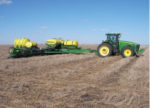Advertise Follow Us
Articles Tagged with ''Fallow''
Constantly Evaluate Technology To Improve Farm Profits
Adopt technology early, hire specialists, increase cropping intensity and seek information from farmers, a young Kansas no-tiller says.
Read More
Hoping For Rain, Counting On No-Till
No-till has not only been better economically for Angela, Mont., farmer Alan Ballensky, the moisture protected by no-till has helped him raise yields that many would not deem possible in such a dry climate.
Read More
What I've Learned from No-Tilling
Teaching And Studying Bring New Insights Into The New-Till World
Finding how no-tilling and organic agricultural practices can benefit one another is just one area that deserves a closer look.
Read More
What I've Learned from No-Tilling
No-Till Is Good For Everyone!
No-till is now at the point where it not only can improve soil structure and stop erosion, but could also have far-reaching effects on consumer preferences and human health.
Read More
Stacking The No-Till Rotation Deck
Rotating crops can benefit your operation, but going against instinct can pay off in a big way. How? Stack ’em.
Read More
Soil Quality Improves With No-Till
The winner of the Phoenix Rotary Equipment Ltd., conservation tillage essay contest explains the benefits of boosting soil quality with no-till and direct seeding.
Read More
Why You’re On The Right Track With No-Till
The long-term conversion to no-till could have more impact than any other innovation on Third World food production.
Read More










